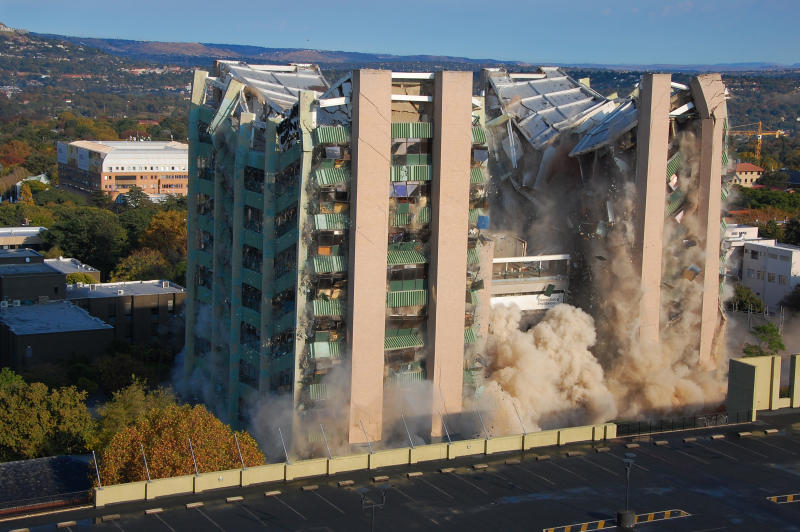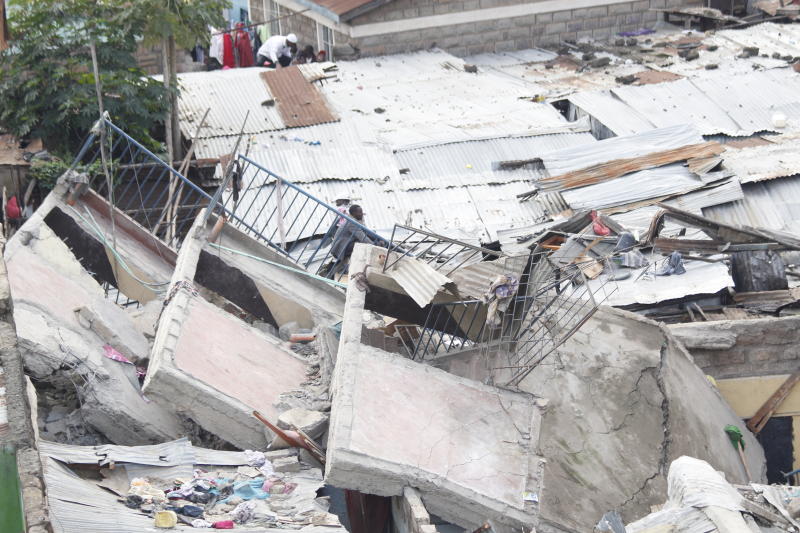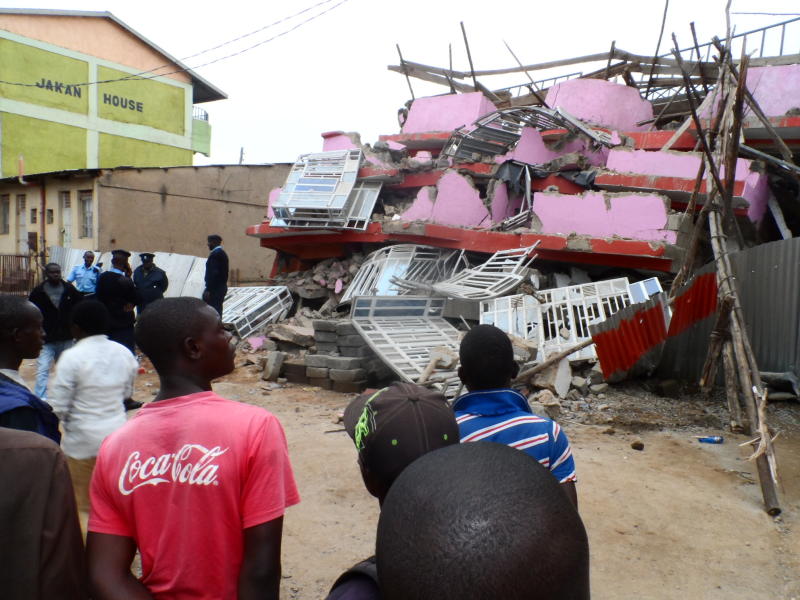
Building demolition by implosion. [Courtesy]
Out of every 100 buildings in Kenya, 35 are likely to “fail”.
This is according to findings by the National Construction Authority (NCA), which has sounded the alarm on the safety of Kenya’s built structures.
Building failure refers to defects observed in how well a structure functions in respect to criteria such as physical, social and environmental considerations.
Performance might be assessed on criteria such as structural integrity, energy consumption and environmental protection.
The NCA research released this week traces the history of collapse of buildings in Kenya and their causes, and seeks to offer solutions.
The earliest documented case of building collapse was in 1990 where a multi-storeyed building in Dagoretti crashed, killing one and injuring others.
Since then, the report says, 87 buildings have collapsed around the country. The peak was in 2015 when 21 failed buildings were recorded.
The report, Failure and Collapse of Buildings in the Construction
Industry in Kenya, cites poor workmanship as the main cause of the
collapse with 51 cases observed, followed by substandard materials with
40 cases and poor structural design with 36.
The Building in Huruma Ngei 3, in Mathare Constituency that came down crumbling killing two people. Pius Maasai the National Disaster Management Unit Acting Director confirmed the two deaths. [File, Phillip Orwa, Standard]
The rest of the cases included non-compliance with statutory and safety requirements with 13 cases and inadequate maintenance with two cases being reported.
The report estimates that over 200 Kenyans died between 1990 and 2019, in the compiled cases of building failures and collapse.
Building failure has also seen the economy lose over Sh2.4 billion, according to the report.
“The value of the loss could be higher because most of the buildings that collapsed were not insured,” said the report.
Out of the 87 documented cases, 66 per cent of the buildings collapsed when they were complete while 34 per cent were under construction.
An audit carried out in 2018 by the National Building Inspectorate covering 14,895 buildings revealed that 723 were very dangerous, 10,791 unsafe, 1,217 fair and 2,194 safe.
“These unsafe and dangerous buildings eventually collapse,” said NCA.
Residential buildings make up the majority of collapsed buildings owing to their high demand.
Police and residents at the scene where a five storied building crumbled last night on April 4, 2018 rendering over five families homeless. Locals accuse the contractor whom they said had done shoddy work where the house located at Juacali estate in kakamega town could be seen with many cracks. [Chrispen Sechere, Standard]
Buildings with between two and six storeys are especially prone to collapse.
Nairobi led with 33 cases followed by Kiambu with 14 cases and Nakuru and Mombasa each with five cases.
“The study established that the building collapses are predominantly found in cities and peri-urban counties. This can be attributed to high demand for residential and commercial buildings in the major towns,” said the NCA report.
It found that few investigations that led to prosecution following the collapse of a building were carried out.
“In ideal situations and also as learnt from best practices, a building collapse is followed by thorough investigation that leads to prosecutions and reforms that strengthen building control processes. Majority of the cases have no clear records of actions taken,” the report said.
“This in a way serves to encourage impunity from greedy investors, unethical professionals and weak institutions that regulate the construction industry,” said the report.
One of the infamous cases was the collapse of a residential building in Huruma, Nairobi in January 2015. The collapse of the seven-storey building killed 52 and injured 32 people.
According to NCA, the building collapsed due to poor workmanship, substandard foundation, inadequate structural design and low quality of concrete mix.
The report further identified lack of a comprehensive construction policy as one of the issues that has left regulation of the industry largely uncoordinated.
“It is therefore recommended that the ministry responsible for construction urgently finalises development of construction policy,” said the report.
“This policy should integrate the design and construction process and address issues of financing, research and development, among others.”
Further, the report recommends the empowering of regulatory
boards to solve unethical practices and enforce professional standards,
and also reviewing the licensing criteria for contractors and
construction workers.
A storey building with 34-rooms that collapsed in Kariobangi South estate in Nairobi leaving tens of families homeless and properties worth millions destroyed. [File, Standard]
It also recommends that NCA be empowered to carry out investigations in cases of building collapse and recommend prosecution.
According to the report, the failure and collapse of buildings were key impediments to investment in the construction industry.
Kenya also lacks a central depository for data on failure and collapse of buildings, making it difficult for monitoring and evaluation.
NCA also recommends that insurance of buildings be made mandatory to cater for any eventualities.
“Insuring buildings would also facilitate access to historical data from insurance companies on failure and collapse of buildings, especially on the value of the relevant investments,” it said in the report.
Commenting on the research findings, NCA Executive Director Maurice Akech, however, cautioned that building failure does not necessarily mean collapse.
“When I talk about failure, I’m not talking about collapse. It could be something that is bordering on safety, maybe there’s no proper lighting inside or the access is not good,” he said.
The findings by NCA come as the institution’s mandate was strengthened by the The Business Laws (Amendment) Act, 2020, which made changes to the National Construction Authority Act, 2011.
This will help fast-track a new Building Code. NCA will have more powers to carry out inspections and undertake quality assurance and, in cases of non-compliance, take action.
“A person who willfully fails to comply with an order of an investigating officer under subsection (3) commits an offence and shall be liable, on conviction, to a fine not exceeding one million shillings or imprisonment for a term not exceeding three years or to both,” says the legal amendment.
Akech said the provision was key and would help rein in rogue developers. He further said NCA would ensure more collaboration with stakeholders and reduce working in silos.
In addition to the research report on buildings failure, NCA released three others on the involvement of micro, small and medium enterprises in the construction industry; appropriate building materials and technologies, and; the need for sustainable waste management practices.




No comments :
Post a Comment